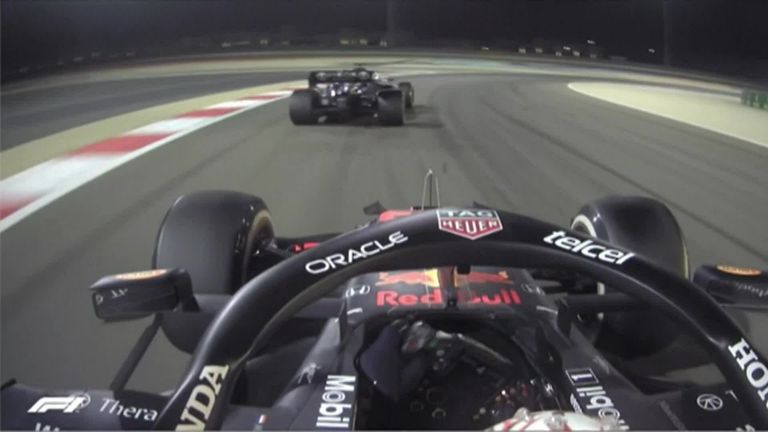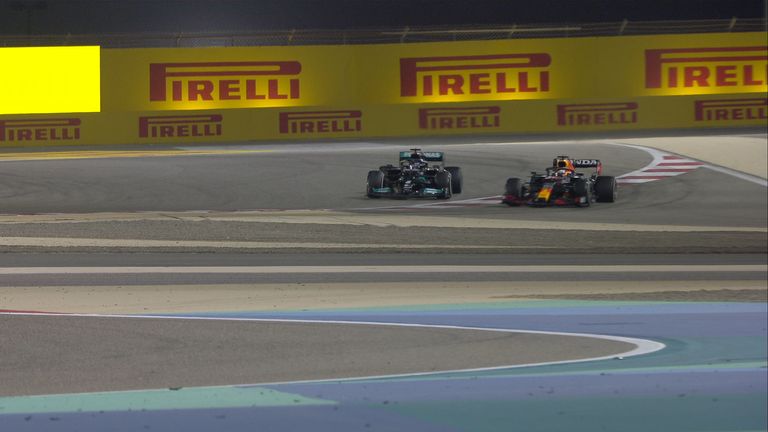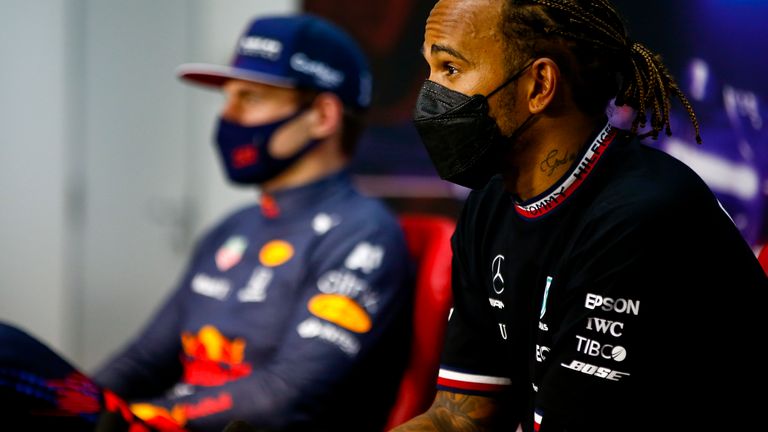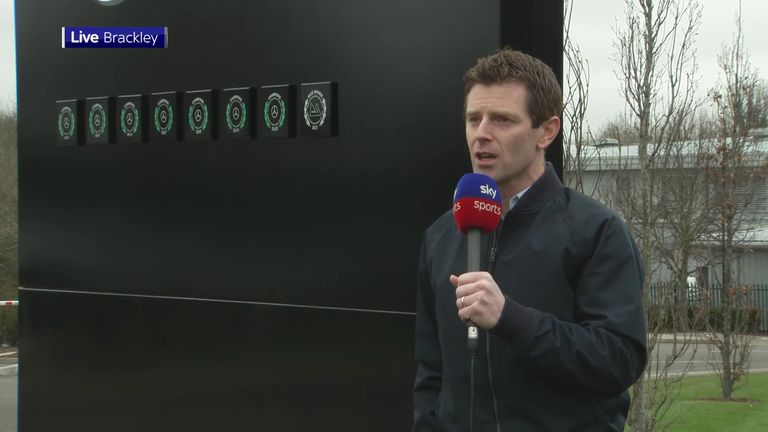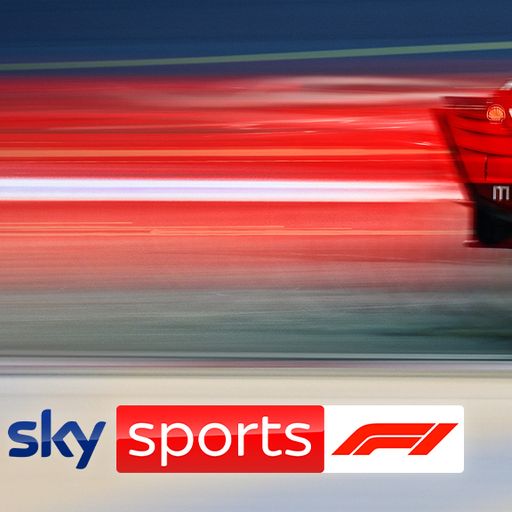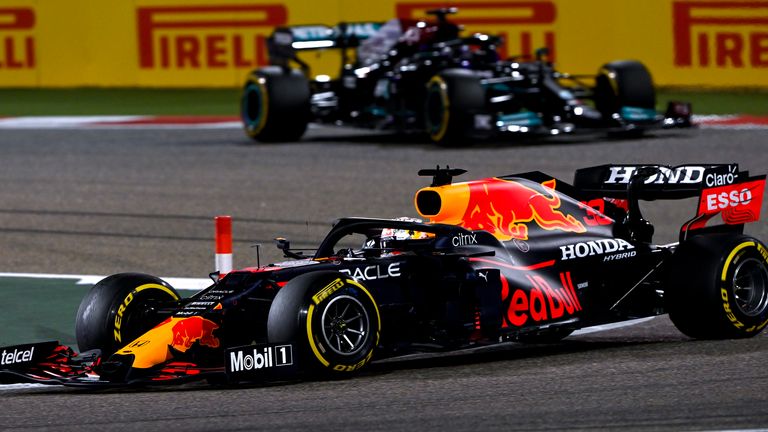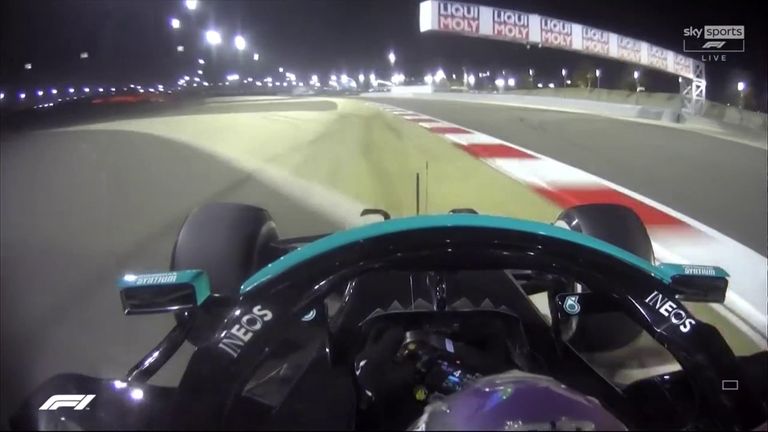Lewis Hamilton vs Max Verstappen: The Red Bull's winning overtake that wasn't and F1 track limits debate
Answering the key questions about F1 track limits after drama and contention in F1's epic season-opening race in Bahrain; Why Max Verstappen had to give Lewis Hamilton the lead back and what would have happened if he hadn't
Monday 29 March 2021 21:09, UK
Why did Verstappen give the lead back after overtaking Hamilton?
In a gripping chase to the finish of the Bahrain GP featuring the two drivers considered the best in Formula 1, Max Verstappen overtook Lewis Hamilton four corners into the race's 53rd lap around the outside of the Mercedes at the undulating Turn Four.
However, the Red Bull driver completed the move with all four of his car's wheels beyond the white lines designating the limits of the track - rendering it an illegal move.
FIA race director Michael Masi swiftly radioed the Red Bull pit wall to tell them that was the case and that Verstappen would have to give Hamilton the place back, which the Dutchman did on the straight out of Turn 10.
Following in the turbulent air of Mercedes for the subsequent fast sweeps towards the end of the lap, Verstappen experienced what he described as a "big oversteer" moment at Turn 13 and appeared to lose tyre performance thereafter.
Hamilton was never challenged to the same extent again and navigated the final laps successfully for a brilliant 96th career win.
- 'Why didn't you let me go?' Max Verstappen falls foul of rules
- Hamilton explains 'immense' Verstappen pressure
- Sebastian Vettel's penalty-laden Aston Martin debut
After the race, Verstappen initially appeared annoyed that he had been asked to cede position rather than wait and take a likely time penalty instead. He said over the radio on his slow-down lap back to the pits: "I prefer to lose a win like that than be second like this."
However, the Dutchman later acknowledged in the press conference that the correct thing to do had been to hand Hamilton the place back.
"I knew that I ran out of the track limits, yeah, and then at Turn 8 they told me, so I gave the position back out of 10. It is what it is," said a philosophical Verstappen.
Had he not ceded position, Verstappen would almost certainly have been handed a time penalty - and Sky F1's Anthony Davidson suspects he would have been lucky to have got away with only five seconds being added to his final race time.
"Checking with stewards, I asked what the ultimate penalty Verstappen could have received for that infringement, and it would have been 10 seconds," said Davidson. "So going against the race directors' request to give that position up, I think they would have come down pretty hard on that."
Could Verstappen have waited longer to give the place back?
One talking point after the race was whether Verstappen could have waited for a more opportune moment to let Hamilton back past him, such as down the circuit's main straight.
However, his team boss Christian Horner quickly shut down that theory by telling Sky F1: "Once you get that instruction, you've got to get out of the way."
Verstappen also admitted that it would have been unfair to let Hamilton through in a place where the Englishman would have been immediate vulnerable to a repass.
"If I would have let him by later then it's an unfair way of giving the position back because then you're so close and it's an easy DRS pass so I had to do it after Turn 10," said the Dutchman.
Hamilton himself was famously penalised and controversially lost a win at the Belgian GP in 2008 when he was deemed to have retaken Kimi Raikkonen too quickly after giving a place back.
After a conversation post-race with Masi, Sky F1's Paul Di Resta revealed: "He said if a car overtakes outside the white line, you've got to let the car back. You've got to give the track position back."
Weren't other drivers going wide at Turn 4? And what's the difference?
Yes, they were - particularly Hamilton - and that's where more general confusion arose during the race as to how track limits at that point of the circuit were being policed with drivers on laps out of combat.
However, there is a distinction between exceeding track limits by running wide and, as stated in the Sporting Regulations, "gaining a lasting advantage" via an overtaking move on another car.
In the initial set of Race Event Notes released by Masi ahead of the weekend on Thursday, drivers and teams were told:
The track limits at the exit of Turn 4 will not be monitored with regard to setting a lap time, as the defining limits are the artificial grass and the gravel trap in that location.
In all cases during the race, Drivers are reminded of the provisions of Article 27.3 of the Sporting Regulations.
An updated version of the document was published after Friday's opening practice session with the following wording:
Practice Sessions a) A lap time achieved during any practice session by leaving the track and cutting behind the red and white kerb on the exit of Turn 4, will result in that lap time being invalidated by the stewards.
Race a) The track limits at the exit of Turn 4 will not be monitored with regard to setting a lap time, as the defining limits are the artificial grass and the gravel trap in that location. b) In all cases during the race, Drivers are reminded of the provisions of Article 27.3 of the Sporting Regulations.
Those overarching Sporting Regulations state this:
Drivers must make every reasonable effort to use the track at all times and may not leave the track without a justifiable reason. Drivers will be judged to have left the track if no part of the car remains in contact with it and, for the avoidance of doubt, any white lines defining the track edges are considered to be part of the track but the kerbs are not. Should a car leave the track the driver may re-join, however, this may only be done when it is safe to do so and without gaining any lasting advantage.
At the absolute discretion of the Race Director a driver may be given the opportunity to give back the whole of any advantage he gained by leaving the track.
What did Hamilton and the FIA say?
Via his race engineer, Hamilton received a warning from race control mid-way through the race about running wide and off the track at Turn Four. "I thought there was no track limits?" a surprised-sounding Hamilton replied, before adding: "I've been doing the same thing all race."
Speaking afterwards, Hamilton claimed that "you're not allowed to overtake off track but halfway through the race, they basically changed their minds and all of a sudden you're not allowed to go outside that white line" (although he acknowledged that it actually helped him preserve his tyres by staying on track).
"It was very confusing," added Hamilton. "Most tracks we're not allowed to put four wheels outside the white line but this weekend on that particular corner we weren't allowed to on Friday.
"In actual fact, you could go two wheels outside the line but you can't go past the blue and white kerb, but in the race you can, and that is what had been written so going into the race then you can."
Masi, however, said there was no mid-race change of policy and that how track limits at that corner were going to be monitored in the race had been made clear to drivers and their teams beforehand.
But, with the policing of track limits regularly proving a thorny issue in many venues across the calendar, the debate over consistency is likely to rumble on.
